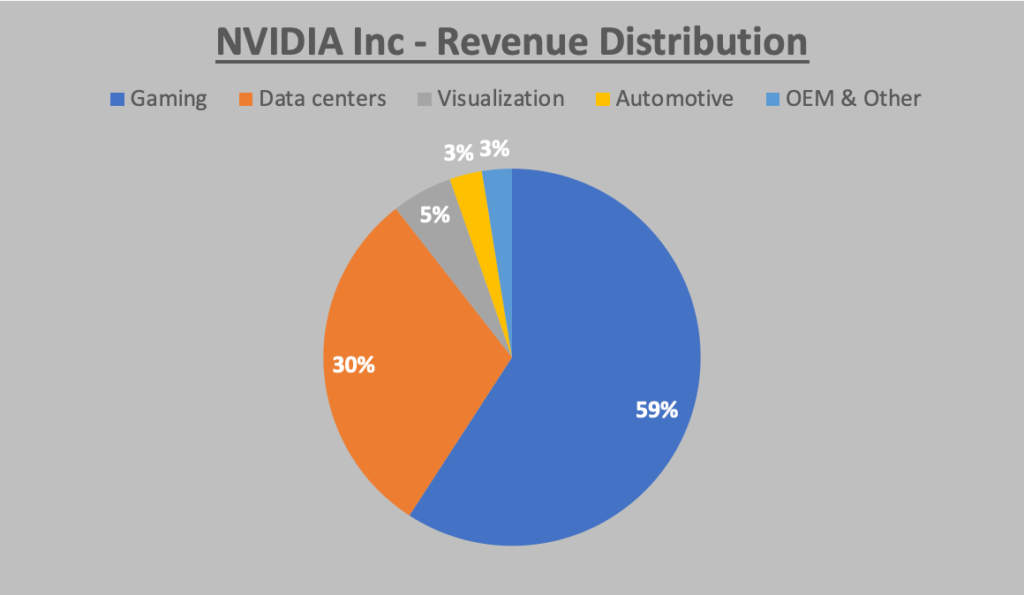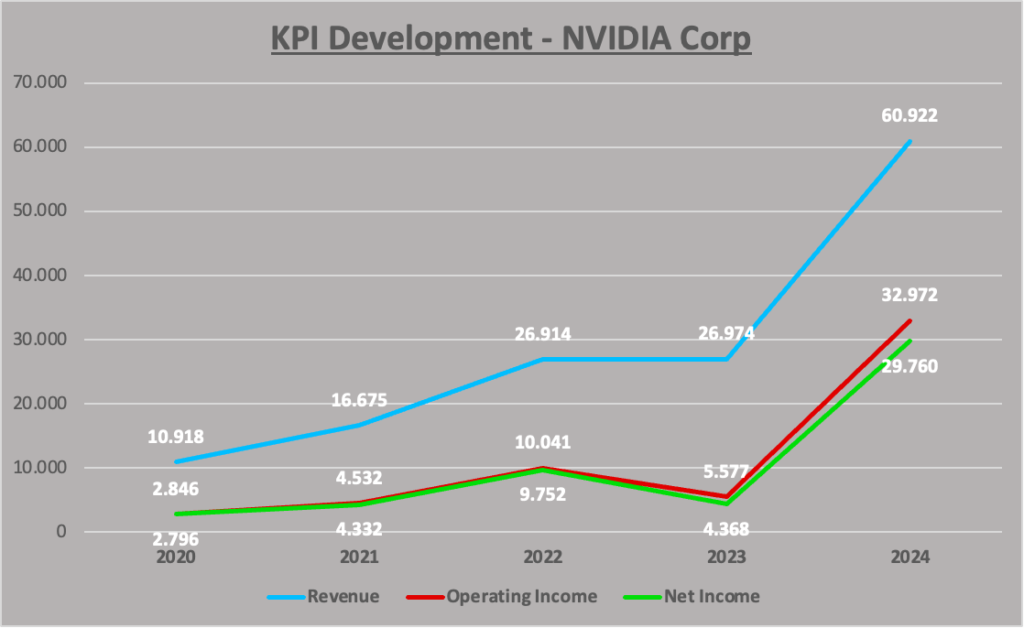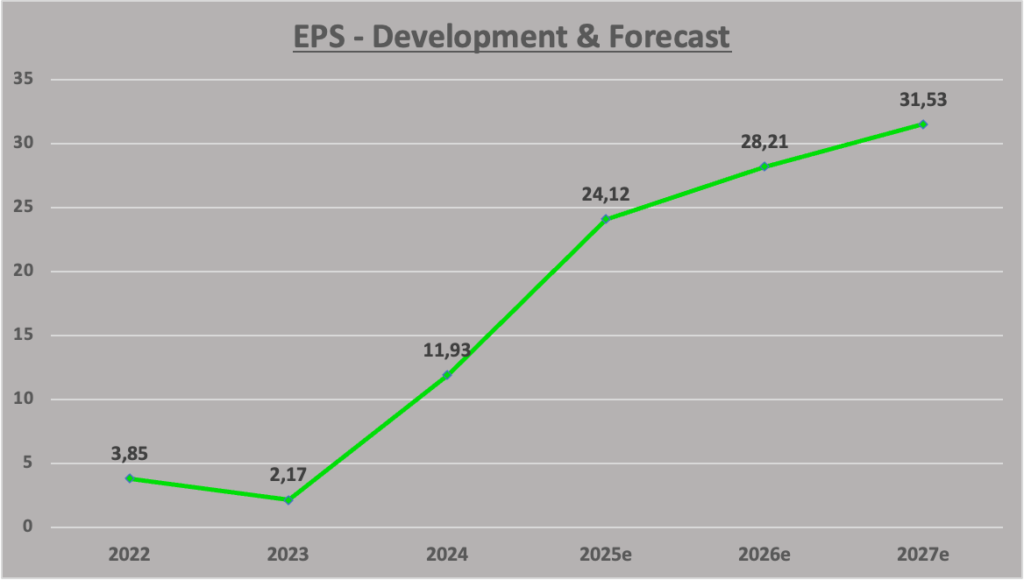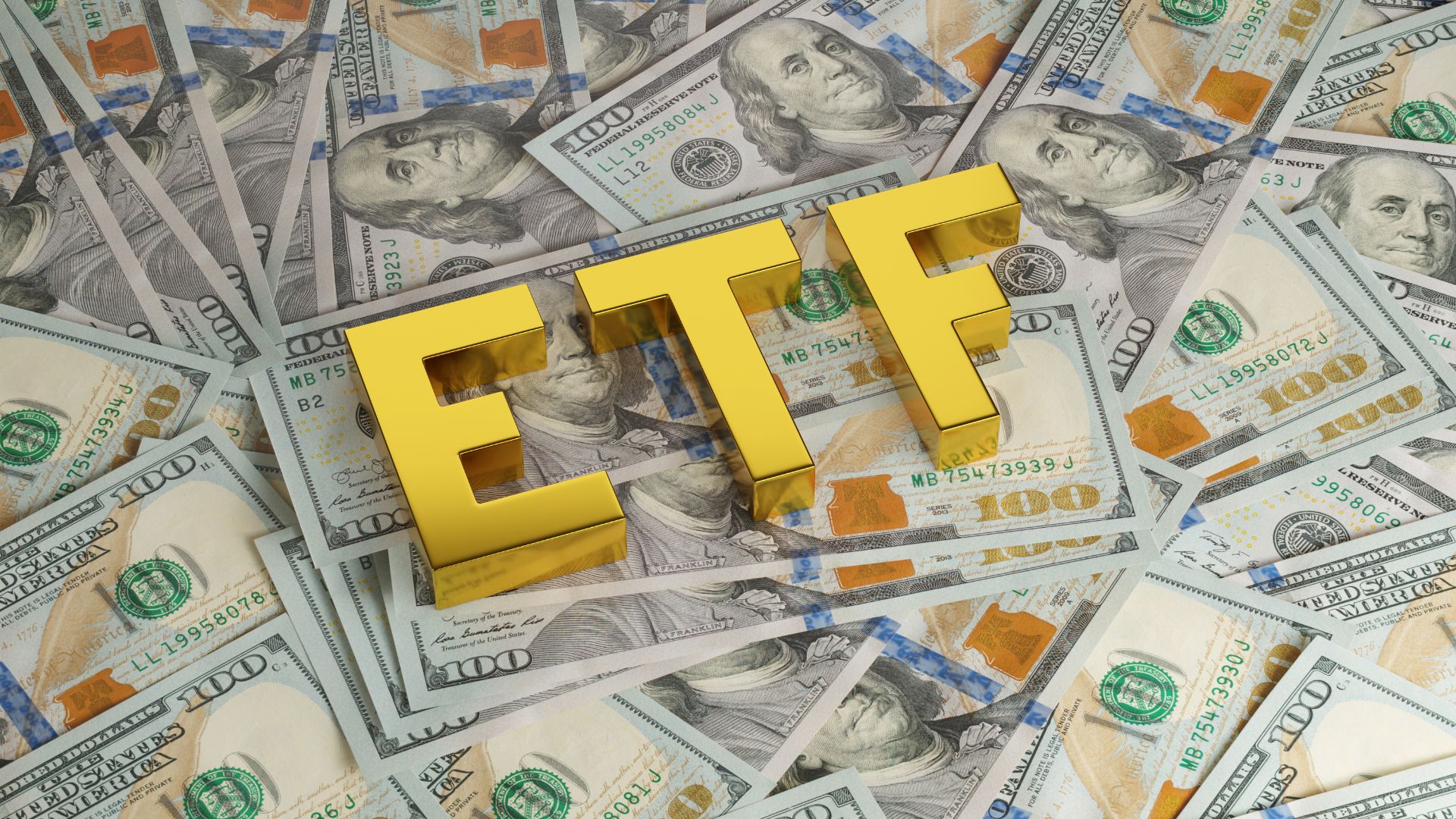In this stock analysis we will learn everything about the NVIDIA stock. We will analyze NVIDIA’s profitability, financial security & growth and in the end we will evaluate the share price. You can then decide whether NVIDIA is a suitable investment for you or not.
Company profile
NVIDIA is a global technology leader at the forefront of accelerated computing. Founded in 1993, they design and develop cutting-edge graphics processing units (GPUs), central processing units (CPUs), and system-on-a-chip (SoC) units. Their products power various markets, including:
- Gaming: Renowned for the GeForce line of graphics cards, beloved by gamers for delivering high-fidelity visuals and smooth performance.
- Professional Visualization: Quadro GPUs fuel the work of designers, architects,and engineers by rendering complex models and simulations flawlessly.
- Data Center & Cloud Computing: DGX systems and TensorRT software accelerate AI workloads in data centers, enabling groundbreaking research and applications.
- Automotive: DRIVE platforms provide the brains behind advanced driver-assistance systems (ADAS) and self-driving cars.
Beyond Graphics:
While graphics remain a core strength, NVIDIA has expanded significantly. They are:
- A dominant force in Artificial Intelligence (AI): Their GPUs are the preferred choice for training and deploying AI models due to their unmatched performance and efficiency.
- Pioneers in the Metaverse: Technologies like Omniverse are shaping the future of virtual collaboration and immersive experiences.
- Driving innovation in various industries: From healthcare and manufacturing to robotics and telecommunications, NVIDIA’s solutions are transforming diverse fields.
NVIDIA is a company at the forefront of technological innovation, shaping the future of computing across diverse industries. From powering immersive gaming experiences to accelerating groundbreaking AI research, their impact is undeniable. As they continue to push boundaries and explore new frontiers, NVIDIA remains a force to be reckoned with in the ever-evolving technological landscape.
Revenue Distribution – NVIDIA
NVIDIA divides its business into five divisions:

Gaming reigns supreme for NVIDIA. According to the company’s revenue distribution, a whopping 59% comes from the sale of graphics processing units (GPUs) targeted towards gamers. This makes sense considering NVIDIA’s GeForce line of graphics cards are some of the most sought-after for high-performance PC gaming.
However, NVIDIA isn’t a one-trick pony. Data centers account for a significant chunk (30%) of their revenue. This segment highlights the growing importance of NVIDIA’s GPUs for artificial intelligence, machine learning, and other high-performance computing tasks within data centers.
The remaining 11% of NVIDIA’s revenue is split between three segments: visualization (3%), automotive (3%), and OEM & Other (5%). Visualization refers to professional applications like scientific computing and design, while automotive points to NVIDIA’s involvement in the development of self-driving cars. The “OEM & Other” category likely encompasses a variety of other uses for NVIDIA’s technology.
Overall, this breakdown showcases NVIDIA’s dominance in the gaming GPU market while also highlighting their growing presence in the data center and other emerging fields.
Based on current trends and industry insights, we can explore some potential developments:
Gaming:
- Potential growth: Continued demand for high-performance gaming, esports growth, and increasing adoption of VR/AR could drive sustained growth in the Gaming segment.
- Challenges: Console cycles, competition from AMD, and market saturation could limit growth potential.
Compute & Networking:
- Strong growth: Increasing demand for AI training and inference, advancements in data center architectures, and the rise of edge computing suggest high growth potential.
- Potential challenges: Economic downturns could impact enterprise spending,and regulatory concerns surrounding AI development could pose some risks.
Competition
NVIDIA faces competition in several key areas, depending on the specific market segment:
- AMD: Their primary competitor in the discrete GPU market, particularly for gaming and professional visualization. They offer comparable performance at lower price points, posing a constant challenge for market share.
- Intel: While primarily known for CPUs, they’ve entered the discrete GPU market with their Arc series. Their integration with CPUs could be attractive to some users, but initial benchmarks suggest performance gaps with NVIDIA.
- Custom AI chips: Companies like Google and Amazon are developing their own custom AI chips for internal use, potentially impacting NVIDIA’s market share in specific segments.
- Semiconductor manufacturers: TSMC and Samsung manufacture NVIDIA’s chips, giving them some leverage in terms of pricing and availability.
Overall, NVIDIA operates in a highly competitive landscape where they need to constantly innovate and adapt to stay ahead. Understanding their key competitors and their strengths and weaknesses is crucial for NVIDIA’s future success.
Profitability – NVIDIA
The first analysis to determine the intrinsic value is profitability.
Stocks with a competitive advantage generate high profit margins, do not require a lot of capital and stand out from the competition. In other words, stocks with a competitive advantage are more profitable than the competition.
To determine this, we first look at the income statement, analyze it, compare the profit margins with the competition and calculate how capital-intensive the business is compared to the competition.
To do this, we take a closer look at the income statement and start by analyzing how much revenue was generated, what costs accrued and what profits were achieved as a result. Here is the income statement stream from NVIDIA:

In the last four quarters, NVIDIA generated sales of around $61 billion, with revenue costs of around $16.6 billion. The approximately $11.3 billion in operating expenses are made up almost three quarters of research & development costs and the rest administrative costs. The non-operating costs and earnings cancel each other out and have no larger effect on profits. After taxes, NVIDIA achieved a profit of 29.8 billion dollars.
Profit Margins
The various margins are of particular interest in the income statement analysis. The higher the margins compared to the competition, the greater the competitive advantage. The emphasis here is on competitive comparison, as companies from the automotive industry cannot be compared with technology companies such as NVIDIA. A comparison only makes sense if the products and services are comparable.
NVIDIA achieves better margins than its competitors:
| NVIDIA | AMD | Intel | TSMC | |
| Gross Margin | 72.72% | 46.12% | 40.04% | 54.37% |
| Operating Margin | 54.12% | 1.77% | 0.06% | 42.65% |
| Net Profit Margin | 48.85% | 3.77% | 3.11% | 38.79% |
Margins from the income statement give us an indication of the profitability of a company. Basically, it can be said that the better the margins compared to the competition, the higher the profitability and the greater the competitive advantage.
However, as already mentioned, the products and services must be comparable with each other. Even if there are many overlaps in this competitive comparison, they are all unique and a comparison should only be made with caution.
Return on Assets
Return on assets (ROA for short) is the most important key figure for analyzing a company’s profitability. ROA is calculated by dividing the profits by the total assets. It shows how much profit a company generates from its assets. The higher the ROA compared to the competition, the better the company’s earning power.
Here is the ROA comparison between NVIDIA and its competitors:
| NVIDIA | AMD | Intel | TSMC | |
| ROA | 58.33% | 1.26% | 0.9% | 15.96% |
As you can see, NVIDIA has by far the best ROA. For now NVIDIA has a competitive advantage.
Financial Security – NVIDIA Corp
After analyzing the profitability, the second analysis for determining the intrinsic value is the financial security of a company. This is because companies that are financially secure and solidly financed give us investors a level of security. While the income statement provides us with information about the operating business, the balance sheet shows us how the company is financed.
To assess the financial security of a company, it is important to look at the ratio between equity and debt. In addition, the company should be able to cope with short-term financial burdens. The debt to equity ratio and the cash ratio are two key figures that can help us with this.
The debt to equity ratio shows the relationship between long-term debt and equity. The cash ratio shows how well short-term liabilities are covered by cash, bank and similar assets. Here is the development of the mentioned KPIs for NVIDIA:
| Cash Ratio | Debt to Equity | |
| 2021 | 2.95 | 0.45 |
| 2022 | 4.89 | 0.45 |
| 2023 | 2.03 | 0.54 |
| 2024 | 2.44 | 0.26 |
This means that current liabilities are well covered and the company is largely self-financed. This is an indicator of a high level of financial security. To put financial security into perspective, here is a comparison with the competition:
| NVIDIA | AMD | Intel | TSMC | |
| Cash Ratio | 2.44 | 0.86 | 0.89 | 1.88 |
| Debt to Equity | 0.26 | 0.05 | 0.47 | 0.27 |
As this comparison clearly shows, NVIDIA has a high level of financial security. Compared to its competitors, its current liabilities are the best secured and its debt ratio is the second lowest.
Growth – NVIDIA Corp
Analyzing company performance is an important part of value investing. It makes it possible to draw conclusions for the future from the past. The income statement provides important information about the development of the company.
Here is the development of revenue, operating income and net income from 2020 to 2024:

In the period from 2020 to 2024, NVIDIA has achieved an increase in sales of +458%, with a significant operating growth combined with a profit increase to around 29.8 bn $.
NVIDIA’s growth compares favorably with its competitors:
| 2020 to TTM | NVIDIA | AMD | Intel | TSMC |
| Revenue Growth | +458% | +132% | -30% | +46% |
| Operating Growth | +1059% | -71% | -99% | +47% |
| Net Income Growth | +964% | -66% | -92% | +48% |
The development of KPIs can provide information about the future development of a company. Although past growth is no guarantee of future growth, companies with a strong performance will generally continue to grow in the future. Companies whose sales and profits are falling, on the other hand, will generally also fall in the future. To create a more accurate forecast, you should also consider the revenue distribution in addition to the KPI development.
Share Price & Forecasts
Now that we have analyzed and evaluated the NVIDIA share, it is time to assess the current price of the share.
The share price is determined by supply and demand. Supply is determined by the company and the shareholders. Demand is determined in the long term by the earnings per share. The more profit a share generates, the more interesting it is for investors.
The P/E ratio, also known as the price/earnings ratio, shows the relationship between the share price and the earnings per share. For example, a P/E ratio of 20 means that a share with a price of $20 has earnings per share of one dollar. (Price = P/E ratio * earnings per share)
The lower the P/E ratio, the better the investment. Unfortunately, this cannot be said across the board, as future developments and forecasts play a very important role. Let’s come back to our example:
We currently have a P/E ratio of 20 and an earnings per share of one dollar.
In the first scenario, we assume that the company will generate earnings per share of $3 next year and even more in the following years. The future prospects are therefore very good, and if this is the case, demand will probably increase.
The second scenario is exactly the opposite. Future expectations are poor and the company is expected to generate only $0.5 per share in the coming year and the following years do not look much better. Here, the share price of $20 is probably too high for many investors and demand is falling.
In the last scenario, it is expected that the company will no longer achieve growth and will remain at a profit of $1 per share in the coming years. The $20 is perhaps just the right price and a stable share for the future.
The various scenarios are purely hypothetical and only reflect reality to a certain extent. But the basic idea between earnings per share, P/E ratio and share price should have been well illustrated.
Earnings per Share – NVIDA Corp
Let’s take a look at the development and forecasts for NVIDIA’s earnings per share (EPS):

EPS of $11.93 is reported for 2024 and the expected values for 2025 to 2027 also mean a significant increase in earnings. With the base value of 2024, NVIDA would achieve an increase of +164% to 31.53$. Based on our analysis, this growth seems plausible, as the competition intensifies. But earnings per share are only half the story, let’s look at the P/E ratio.
P/E Ratio Development – NVIDIA Corp
Here is the development of NVIDIA’s P/E ratio from 2021 to 2024:

A P/E ratio of less than 20 is considered undervalued, a P/E ratio of more than 25 is considered overvalued. NVIDIA has a P/E ratio of 51. This would mean that the share is overvalued.
Over the last four years, NVIDIA’s average P/E ratio is around 75.6, which means it is generally overvalued. To get a more accurate valuation, we should link the P/E ratio with EPS.
Share Price – Forecast
First, we link the EPS forecasts with NVIDIA’s P/E ratios. In the first scenario, we assume that demand for NVIDIA shares will remain the same over the next few years. This would result in the following share price forecasts:
| EPS-Forecast | P/E Ratio | Share Price – Forecast | |
| 2025e | 24.12$ | 51.57 | 1,243$ |
| 2026e | 28.21$ | 51.57 | 1,454$ |
| 2027e | 31.53$ | 51.57 | 1,626$ |
NVIDIA’s share price currently stands at $926.69 (as of 07.03.2024). Based on this scenario, NVIDIA’s share price performance looks good. To be precise, an increase in value of around 75% by 2027.
In a second scenario, we expect demand to be conservative, so we assume a P/E ratio of 20-25, which can generally be considered fair.
| EPS-Forecast | P/E Ratio | Share Price – Forecast | |
| 2025e | 24.12$ | 20-25 | 482$ – 603$ |
| 2026e | 28.21$ | 20-25 | 564$ – 705$ |
| 2027e | 31.53$ | 20-25 | 630$ – 788$ |
In this scenario, NVIDIA would not experience any increase in value.
I would not recommend a third scenario with rising demand, because you should always allow for a margin of safety when making forecasts, as the future is uncertain.
Summary
Company
- NVIDIA designs graphics processing units (GPUs) used in various markets like gaming, professional visualization, data centers, and automotive.
- They are a leader in Artificial Intelligence (AI) and are shaping the future of virtual collaboration (metaverse).
Revenue Distribution
- Gaming is their biggest revenue source (59%), with GeForce being a popular graphics card choice for gamers.
- Data centers are another major contributor (30%) due to the demand for NVIDIA’s GPUs in AI and high-performance computing.
- The remaining 11% comes from visualization (professional applications), automotive (self-driving cars), and other uses.
Competition
- NVIDIA faces competition from AMD, Intel, custom AI chips by tech giants, and chip manufacturers like TSMC and Samsung.
Profitability
- NVIDIA boasts higher profit margins than competitors, indicating a competitive advantage.
- This is supported by their Return on Assets (ROA).
Financial Security
- NVIDIA has a strong financial position with a good cash ratio and low debt-to-equity ratio, indicating they are self-financed and secure.
Growth
- NVIDIA has experienced significant revenue and profit growth in recent years.
Share Price & Forecasts
- The current P/E ratio suggests the stock might be overvalued based on historical averages.
- The future share price depends on factors like EPS growth and investor demand.
- Two scenarios are presented:
- Scenario 1: Assuming constant demand, the share price could increase by 75% by 2027.
- Scenario 2: Assuming conservative demand (P/E ratio of 20-25), the share price wouldn’t experience significant growth.
- I recommend a margin of safety when making forecasts due to future uncertainties.
Disclaimer
This article is not financial advice and does not constitute a recommendation to buy or sell stocks. The information in this article is based on the personal opinions of the author and should not be construed as investment advice.
The author assumes no liability for any damages resulting from the use of the information in this article. Readers should inform themselves independently before investing in stocks and only make an investment decision after their own examination. An investment in shares can lead to a total loss of capital.
All figures on NVIDIA and the share are from Gurufocus.
Gurufocus offers a comprehensive and intuitive platform that simplifies our work as value investors. With comprehensive financial data and a stock screener with more than 500 filters, you can quickly find the right stocks and analyze them immediately. It is my absolute go-to tool for my stock analysis and you can test it for 7 days free of charge and see for yourself.



